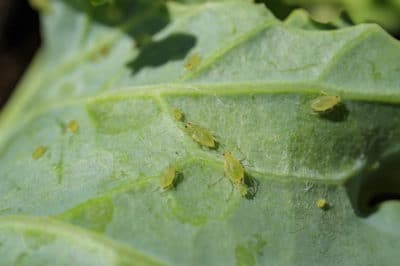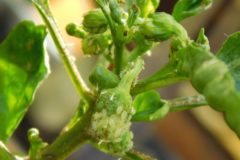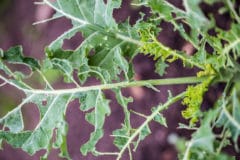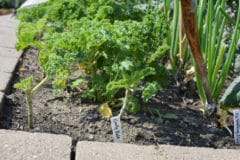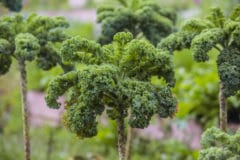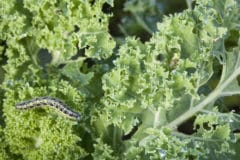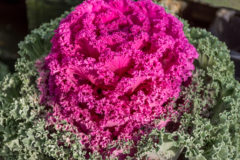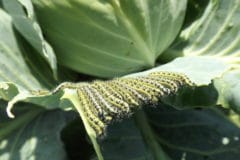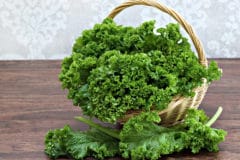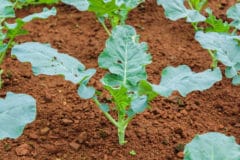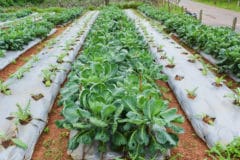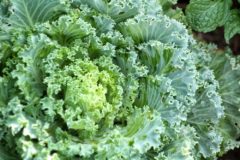Identifying Aphids
The cabbage aphid, which is the species that attacks kale, is gray-green with a waxy covering that protects it from predators. Entire clusters of these aphids may be covered with the waxy droplets which are secreted by the insects. This coating sometimes makes them appear to be grayish-white or powdery blue.
Like all aphids, cabbage aphids are tiny, measuring less than ¼ inch long. They are pear-shaped, soft-bodied insects, with weak legs and long antennas. Many aphid species lurk on the underside of plant leaves, but cabbage aphids seek shelter in the crook where a leaf joins a stem.
Why the Aphid Population Must Be Controlled
One female aphid may give live birth to from 50 to 100 offspring in one growing season, and between spring and fall, cabbage aphids can produce as many as 41 generations. That means that every aphid that appears in the spring could have as many as five billion descendants by fall.
Identifying Damage Done by Aphids
Cabbage aphids feed by sucking fluids from kale through a tube inserted into the leaf or plant stem, and, for that reason, they prefer seedlings or tender new growth. They usually feed in large clusters rather than singly. The loss of fluids and chlorophyll caused by this mass feeding causes leaves to become yellow, stunted, or misshapen. Eventually, the leaves curl up and then drop off of the kale.
Controlling Aphids
Aphids can be controlled with homemade organic sprays, natural predators, and companion planting.
Natural Predators
Adult ladybugs, properly referred to as lady beetles, and their larva; lacewings; and hoverfly larva all feed on aphids. All of them, especially lady beetles and lacewings, may already be present in your garden.
Ants also are already present in your garden, and, like some of the helpers above, some ants feed on the honeydew secreted by some aphids. Some ants stroke aphids, “milking” them for honeydew. Some even take aphids into their ant hills.
So, if you have ants crawling up and down your plants, it’s a sign that you have aphids. You also have ants who will be ready, willing, and able to defend their aphids against your predators, so you may have to fight the ants while your predators fight the aphids.
Lady Beetles
Lady beetles have the cheerful and familiar black polka dots on their red or orange backs. They lay their clusters of yellow to orange eggs on leaves, usually near a colony of aphids.
The larva, which are dark brown or black with yellow or red flecks and which resemble miniaturized alligators, hatch after about a week. Newly hatched larva can eat several dozen aphids in a single day while more mature larva can eat more than 100 a day. The larva will also feed on any small caterpillars that they find on your kale.
After about a month, the larva enter the pupa stage before emerging as adults, and the adults also feed on both aphids and small caterpillars.
If lady beetles aren’t already present in your garden, they can be purchased and released. However, they sometimes depart after release, even when an ample supply of food is present.
Lady beetles emerge earlier in the spring than the other aphids predators, so you can attract them by growing a diverse range of pollen and nectar producing plants, especially early blooming mustard, and by allowing a small colony of aphids to develop in the spring.
Lacewings
Lacewings have delicate, transparent wings and green or brown bodies that measure from ½ to 1 inch long. They emerge at night to feed, mate, and lay their stalked eggs on the underside of leaves near an aphid colony or near other soft-bodied insects.
Lacewings are drawn to the leaves by the scent of caterpillar frass (excretions) and the scent of the honeydew secreted by some aphids. A single female can lay more than 400 eggs.
The larva are dark colored and are either hump-backed or plumper in the middle with more slender heads and tails and long bristles that collect debris that acts as protective camouflage from birds.
Lacewing larva are referred to as aphid lions or aphid wolves because of the hooked pincers on their jaws and because of their ravenous appetite. Each larva can consume about 600 aphids in one month. In addition to aphids, the larva consume small caterpillars, caterpillar eggs, whiteflies, and mealybugs.
As with lady beetles, you can attract lacewings by growing a diverse range of plants. Avoid pesticides, and, in the evening, remove the row covers from your kale to allow the lacewings to reach your plants.
If you notice aphids on your kale, spray the kale lightly with a mixture of one tablespoon of sugar to one cup of water. This stimulates the aphids to produce more honeydew, which draws both lacewings and lady beetles to them.
If you have a sufficient food source for lacewing adults, your can purchase them for release in your garden or your greenhouse.
Hoverflies
Hoverflies are also called syrphid flies, and the adults measure only 5/8” long. With their black and yellow stripes, they could be mistaken for small yellow jackets, but they only have two wings, not four, and they do not bite or sting.
Hoverflies are most active late in the morning, and they scatter their eggs around on leaves near aphids and other soft-bodied insects. Although you need a magnifying glass to see the larva, they feast on aphids, mites, scale, and thrips.
The adults feed on nectar, and, consequently, they help to pollinate some plants. You can attract hoverflies by planting:
- Bachelor buttons
- Buckwheat
- Catnip
- Garlic chives
Homemade Sprays
Both tomato leaf spray and garlic oil spray can help control aphids. However, a word of caution is in order for each spray.
Garlic contains sulfur. Sulfur is a triple threat pesticide, fungicide, and anti-bacterial agent all in one, but it is an indiscriminate pesticide that can kill the beneficial insects above as well as aphids and other pests.
So, only use garlic oil spray if you have not seen any beneficial insects in your garden. If you already have some of these insects, give them a helping hand with tomato leaf spray instead. Tomato leaf spray is not harmful to beneficial garden insects.
Tomatoes are related to nightshade, and tomato leaves contain the same toxic alkaloids that are contained in nightshade. These alkaloids are released when the tomato leaves are chopped, and some people are allergic to them.
So, if you know you are allergic to nightshade or you have a reason to suspect you might be, such as having a relative who is allergic, take appropriate precautions when making and using this spray – gloves, long sleeves, long pants, hand washing, avoiding application on windy or breezy days, etc.
Garlic Oil Spray
To make garlic oil spray, add three or four minced garlic cloves to two teaspoons of mineral oil and let them sit for 24 hours. Strain the minced garlic from the mixture and combine it with one pint of water and one teaspoon of liquid dishwashing soap.
Test the spray on a small, inconspicuous area of one kale plant before using it on all of your plants. If the leaves turn yellow or show other signs of damage, add more water to dilute the spray. Continue testing and diluting the spray until the leaves no longer show any sign of damage.
Then, you can apply the spray to entire plants, particularly to the underside of leaves and, on kale, the place where the leaves join the stem where cabbage aphids are most likely to gather. Apply every three days until the aphids disappear.
You can dilute and store garlic oil as needed. Different crops may need different strengths of the solution, so be sure to carefully label each combination accordingly.
Tomato Leaf Spray
To make tomato leaf spray, let one to two cups of chopped tomato leaves steep overnight in two cups of water. Use a fine strainer or cheesecloth to remove the leaves, add one to two cups more water, and place the solution in a spray bottle.
Apply the tomato leaf spray to infested plants, especially to the areas where aphids most frequently gather. As with garlic oil spray, apply every three days until the aphids are gone, or until the aphid colony can be kept under control by your insect helpers.
Companion Planting
Companion plants can provide various benefits to other plants when they are planted in the same area of your garden. Some plants just simply grow better when planted close together. Some draw beneficial insects to your garden while others repel pests or lure pests away from other plants.
Plants that lure or repel aphids include:
- Catnip – repels aphids
- Mustard – lures aphids
- Nasturtiums — lure aphids
Since aphids have weak legs, plant mustard and nasturtiums close to your kale so that the aphids are able to crawl across the leaves to reach them. Nasturtiums also help to draw the insects that prey on aphids to your garden.
Other plants that draw lady beetles, lacewings, and hoverflies to your garden include:
- Borage
- Calendula
- Cosmos
- Sweet alyssum
- Zinnias
Other Methods for Controlling Aphids
Here are other methods you can use to control aphids:
- Remove the leaves that contain the aphids from your kale and add them to your compost.
- To save the leaves, scrape the aphids off with a toothpick.
- Remove badly infested plants from your garden and destroy them.
- Flick aphids off leaves with cold water from a hose every few days. Because aphids have weak legs, they will have difficulty climbing back up the stem to reach the kale leaves.
- Spread diatomaceous earth on the ground at the base of your kale. It will pierce aphids, caterpillars, and other soft-bodied insects that crawl over it.
- Dust plants with flour to give the aphids constipation.
- Put a few drops of liquid dishwashing soap in water and spray or wipe it on the kale leaves.
- Add a pinch of cayenne pepper and one teaspoon of liquid dishwashing soap to a quart of water and spray it, undiluted, on the leaves of plants.
Solutions of isopropanol (rubbing alcohol), especially ethanol (grain alcohol) offer three other options for insecticidal sprays:
1. Mix equal amounts of water and 70 percent alcohol.
2. Mix 1 ½ parts water with 1 part 95 percent alcohol.
3. Mix one tablespoon liquid dishwashing soap, two cups alcohol, and five cups water.
Two Additional Notes
When using alcohol or liquid dishwashing soap in any mixture you intend to apply to kale or other edible plants, look for the purest versions with no additives and rinse the leaves thoroughly before using them.
Also, as with garlic oil spray, always test sprays containing liquid dishwashing soap or alcohol on a small area of one kale plant in either the morning or evening, and watch the plant for a few days for signs of distress or damage before using those sprays to treat other plants.
